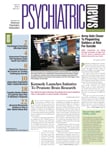Preliminary findings from a massive study of U.S. Army data reveal patterns of risk factors associated with suicide and suggest further avenues of inquiry, according to the National Institute of Mental Health (NIMH).
The report covered data on 900,000 soldiers who served at some time in Iraq or Afghanistan from 2004 to 2008. All were regular, active-duty troops, not members of the National Guard or Reserve. In that period, 389 soldiers killed themselves.
The Army accumulated information about suicide, accidental, and combat deaths as part of a dozen administrative and health-related datasets that it combined into one large research database. The data were then given to NIMH for analysis.
From the start of the Army Study to Assess Risk and Resilience in Service-members (referred to as Army STARRS), researchers planned to release data periodically, first to the Army and then publically, said study co-director Robert J. Ursano, M.D., a professor of psychiatry and neuroscience, chair of the Department of Psychiatry, and director of the Center for the Study of Traumatic Stress at the Uniformed Services University of the Health Sciences in Bethesda, Md.
"We're using an adaptive design meant to provide real-time information to the Army as soon as it's available in order to inform potential interventions," said Ursano in an interview.
During the study period, Army suicide rates rose significantly, from about 10 per 100,000 to more than 20 per 100,000.
"Each of these is a tragic event, especially when death occurs because of something you consider preventable," said NIMH demographer Michael Schoenbaum, Ph.D., who works on and is a spokesperson for the Army STARRS study.
Suicide was a "rare statistical outcome" no matter whether the soldier was deployed to Iraq or Afghanistan, had returned from a deployment, or had never been deployed, Schoenbaum told Psychiatric News. However, potential patterns have emerged from the preliminary study.
In one widely reported statistic, for instance, suicide rates among deployed women soldiers appeared to rise dramatically, from 5.1 in 2004 to 15.2 per 100,000 in 2008. However, the rate must be viewed with caution. The number of deployed women is relatively low, so that rate is based on a total of 22 women who committed suicide during that period, including eight of the 113 suicides that occurred during deployment.
Nonetheless, the rates for women were still lower than for men before, during, and after deployment, although they rose much higher while in the war zones, he said. Women represented 10 percent of deployed soldiers but accounted for 7 percent of suicides of deployed soldiers.
Asian ethnicity appeared initially to be a risk factor, too. The Army asks recruits to identify themselves as white, black, Asian, Native American, or other. So U.S. soldiers who call themselves Asian might have ancestors from China, Japan, Korea, Vietnam, India, Pakistan, or other countries—covering a wide geographic, genetic, and cultural swath. They might be born in the United States or they might be immigrants, adding another variable to their background.
While these self-identified Asians make up 3.5 percent of the Army, they accounted for 9.5 percent of the suicides, although again the absolute number was small—37 individuals in the four-year period. The disparity was evident before, during, and after deployment.
Among protective factors, researchers found that being married appeared to protect soldiers against death by any means, including accidents and combat, as well as suicide, said Schoenbaum. Married soldiers on deployment commit suicide at a rate of 15 per 100,000, compared with 24.5 per 100,000 among never-married troops.
"But we don't know why, even after we control for age, family composition, rank, and time in service," he said. "The Army doesn't treat married soldiers differently."
Combining multiple risk and protective factors may eventually permit more precise targeting of suicide prevention interventions, said Schoenbaum.
In the current analyses, the researchers looked at the statistical association between suicide death and soldiers' age, sex, marital status, race, religion, education, rank, promotions, demotions, "stop-loss" status (soldiers who are involuntarily retained beyond their contracted enlistments), and length of Army service, he said.
To examine the concentration of risk posed by numerous variables, they estimated that "predicted" annual suicide risk ranged between three and more than 400 suicides per 100,000 persons for soldiers with the lowest- and highest-risk patterns of characteristics, respectively. They calculated that the 5 percent of soldiers with the highest predicted suicide risk based on this analysis accounted for some 22 percent of the actual suicide deaths from 2004 to 2008.
This early finding suggests it may be possible to develop and apply empirical methods to identify a relatively small number of soldiers who are at particularly high suicide risk, to aid prevention and treatment efforts, said Schoenbaum.
Still under study are the effects of military specialty, unit assignment and casualty rates of units, personal weapons or vehicles owned, disciplinary problems, failed drug tests, and involvement with the criminal-justice system. In addition to suicide deaths, researchers will review nonsuicide deaths, nonfatal suicide attempts, suicidal ideation, depression, and post-traumatic stress disorder.
"We will have more refined information in less than a year," said Schoenbaum.
However, there is a limit on the value of predictive factors.
"Most people with risk factors never attempt to hurt themselves, and a minority of people who commit suicide have no risk factors," he said. "Our challenge is to help the Army focus its preventive efforts on empirically identified risk groups. Ultimately our task is to provide ‘actionable’ results—practical, useful information that the Army can use to help real people."
Much more work remains to be done in the study, said Ursano. The researchers will eventually draw on "massive" datasets covering thousands of soldiers.
"This is an early, cross-sectional look at single variables that leaves us with a number of potential explanations," he said. "There are limitations attached to the data released now, but there is always a challenge between science and the need for making decisions about national security."
